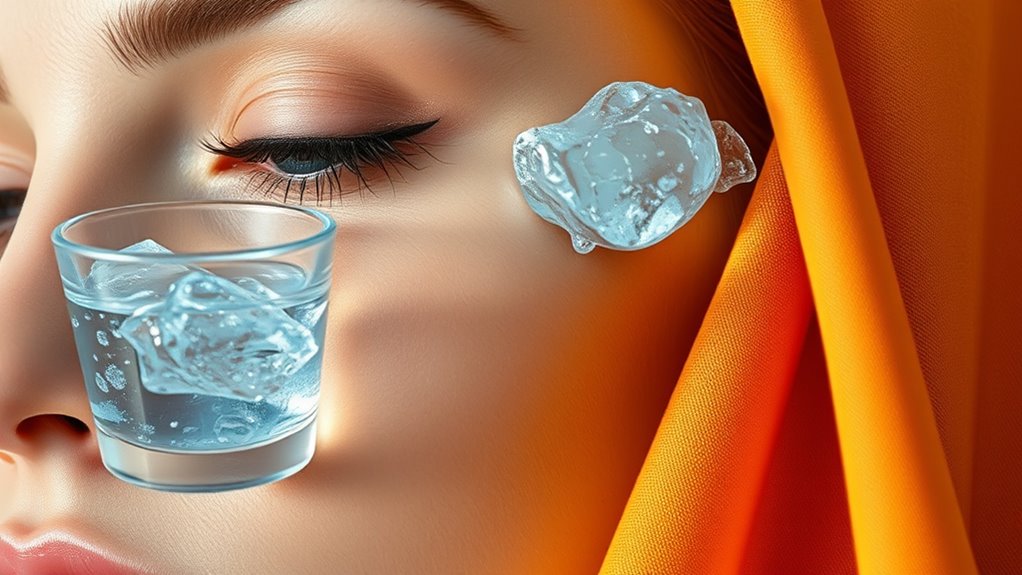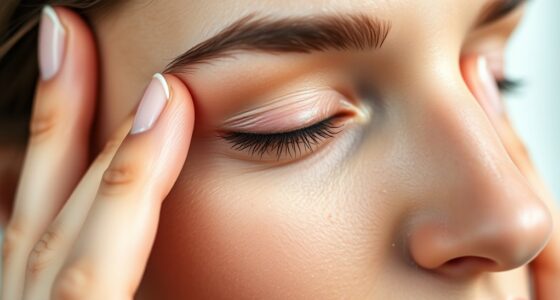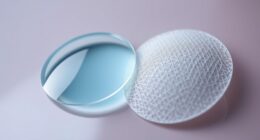Using a cold compress around your eyes helps reduce swelling, puffiness, and inflammation, offering quick relief from tired or irritated eyes. Warm compresses, on the other hand, promote blood flow, loosen mucus, and ease sinus pressure, especially during sinus headaches or congestion. Knowing when to switch between them can make a big difference in how you feel. Keep going to discover more about choosing the right relief for your eye comfort needs.
Key Takeaways
- Cold compress reduces swelling, puffiness, and inflammation around the eyes, ideal for post-sleep or allergy-related puffiness.
- Warm compress promotes circulation, relieves sinus pressure, and eases sinus pain, suitable for sinus congestion and headaches.
- Use cold compress for immediate relief of tired, swollen eyes, applying for 10-15 minutes to constrict blood vessels.
- Apply warm compress to relax muscles, loosen mucus, and improve blood flow in the sinus area, enhancing breathing comfort.
- Choose the temperature based on symptoms: cold for inflammation and swelling, warm for sinus pain and muscle relaxation.

Ever wonder whether a cold or warm compress is better for your injury or discomfort? When it comes to the delicate area around your eyes, knowing which to use can make a big difference. Whether you’re dealing with eye puffiness or sinus issues, choosing the right compress can help you find relief faster. Cold and warm compresses each have their unique benefits, and understanding when to use them ensures you get the most effective treatment.
If you’re experiencing eye puffiness, especially after a restless night or allergies, a cold compress can be your best bet. The cool temperature helps constrict blood vessels around your eyes, reducing swelling and inflammation. Applying a cold pack or a chilled spoon gently on your closed eyelids can provide immediate relief, making your eyes look less swollen and tired. The cold also numbs the area slightly, easing discomfort and giving you a refreshed appearance. Plus, a cold compress can help soothe irritation caused by allergies or minor eye injuries, offering quick, non-invasive relief.
On the other hand, if your sinus area feels congested or you’re battling sinus headaches, a warm compress might be more effective. Applying warmth promotes circulation, helping to loosen mucus and relieve pressure in your sinuses. When you gently press a warm, damp cloth over your face, especially around your cheeks, nose, and forehead, it encourages blood flow and facilitates drainage. This can noticeably reduce sinus pain and provide a comforting sensation, easing breathing difficulties. Warm compresses also help relax the muscles around your eyes, which can become tense during sinus discomfort, alleviating tension and promoting relaxation.
It’s important to use each compress appropriately. For eye puffiness and swelling, stick with cold applications for no more than 10-15 minutes at a time to prevent skin damage. For sinus relief, a warm compress can be applied similarly, but ensure it’s comfortably warm and not hot to avoid burns. Always listen to your body—if the area feels too cold or hot, remove the compress immediately. If your symptoms persist or worsen, consult a healthcare professional to rule out underlying issues.
Frequently Asked Questions
Can Compresses Improve Dark Circles Around the Eyes?
Yes, compresses can improve dark circles around your eyes. A cold compress reduces eye puffiness and constricts blood vessels, making dark circles less visible. It also soothes tired eyes. A warm compress promotes skin tightening and increases blood flow, which can help diminish shadows under your eyes over time. Incorporate these techniques into your routine based on your specific needs for effective results.
How Long Should I Apply a Warm Compress?
Imagine soothing warmth like a gentle hug for your eyes. For warm compresses, stick to the duration guidelines of 10-15 minutes to avoid overstimulation. Use application techniques that keep the compress comfortably warm, not hot. This careful timing helps relax the muscles and improve circulation without causing irritation. Remember, patience and gentle application are your best allies in nurturing your eye area.
Are There Any Risks With Using Cold Compresses?
Using cold compresses can pose risks like skin irritation or infection if you don’t take proper precautions. Avoid applying ice directly to your skin; instead, wrap it in a cloth. Limit use to 10-15 minutes to prevent frostbite or irritation. Always clean the compress thoroughly after each use to minimize infection risk. If your skin becomes red or irritated, discontinue use and consult a healthcare professional.
Can Compresses Help With Eye Allergies?
Yes, compresses can help with eye allergies by reducing eye puffiness and providing tear relief. Applying a cold compress gently on your closed eyes can soothe irritation and decrease swelling. It tightens blood vessels, which helps lessen puffiness and eases discomfort. Use a clean, cold cloth for a few minutes, and you’ll notice your eyes feeling calmer and more refreshed, especially during allergy flare-ups.
Is It Safe to Use Both Warm and Cold Compresses Alternately?
Yes, you can safely alternate warm and cold compresses for eye strain or cosmetic benefits, but do so carefully. Apply each compress for 10-15 minutes, with at least a 10-minute break in between. This method can soothe your eyes, reduce puffiness, and improve circulation. Always make certain the compresses are clean, and avoid extremes of temperature to prevent skin irritation or damage. If discomfort persists, consult a healthcare professional.
Conclusion
So, next time your eyes feel puffy or tired, remember that the right compress can make a difference—whether it’s cold to reduce swelling or warm to soothe. It’s funny how a simple trick like applying a compress can turn a rough day around, almost like a small coincidence of self-care. Just trust your instincts and choose what feels best in the moment—you might be surprised at how such a tiny change can brighten your entire day.








